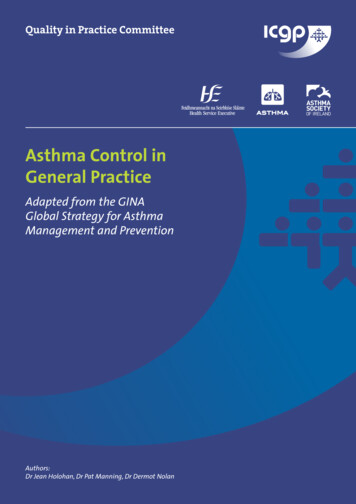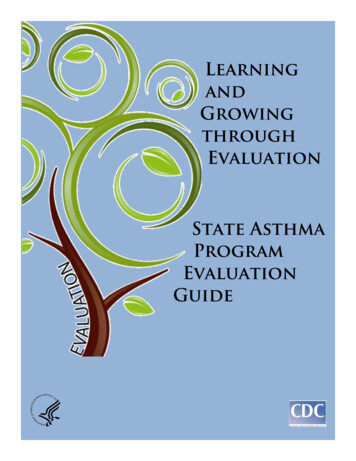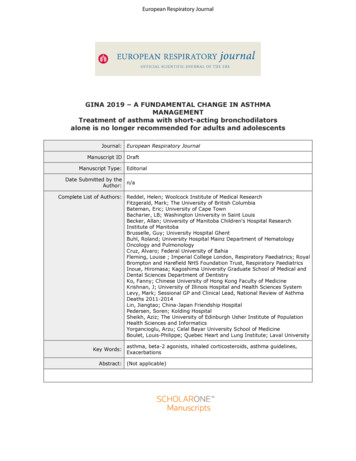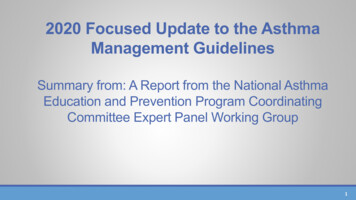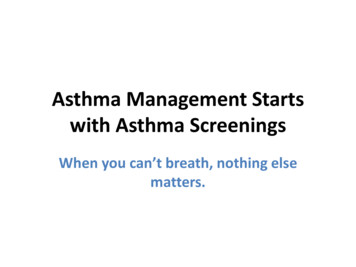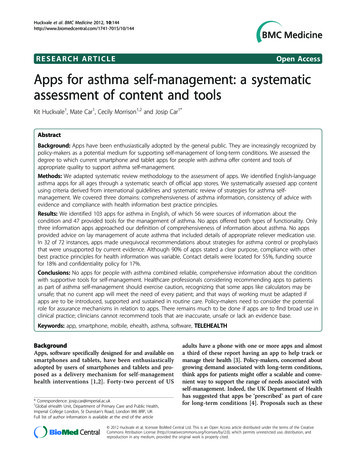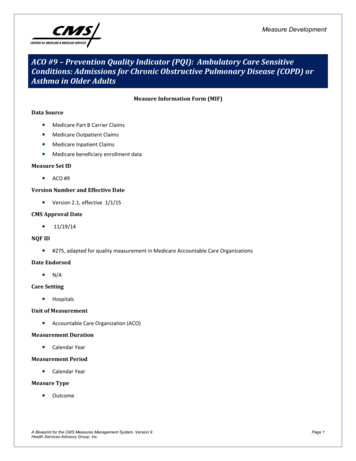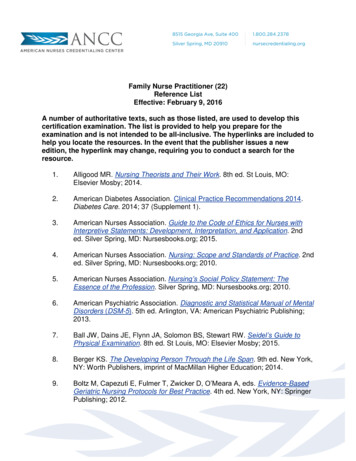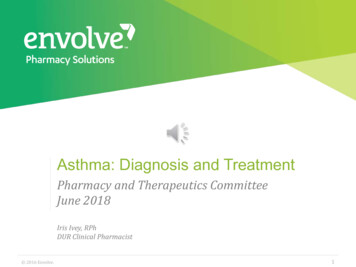
Transcription
Asthma: Diagnosis and TreatmentPharmacy and Therapeutics CommitteeJune 2018Iris Ivey, RPhDUR Clinical Pharmacist 2016 Envolve.1
Objectives Review of the societal impact of asthmaReview of hereditary and environmental factors of asthmaGoals of asthma therapyPharmalogical treatment of asthmaPatient’s role in asthma care and treatment 2016 Envolve.2
Societal Impact of AsthmaAsthma is the 14th most important disorder in the world in terms of the extentand duration of disability. Asthma is responsible for about 5,000 deaths and about 2.5 millionhospitalizations or emergency department visits yearly. Asthma also results in a yearly loss of millions of school and work days. 14% of the world’s children experience asthma symptoms. 8.6% of young adults (aged 18-45) experience asthma symptoms. 4.5% of young adults have been diagnosed with asthma and/or are takingtreatment for asthma. The burden of asthma is greatest for children aged 10-14 and the elderly aged75-79. Black and Hispanic (Puerto Rican) populations have disproportionately higherrates in poor outcomes, hospitalizations, and deaths in the United States. The total cost is estimated to be 19 billion per year. 2016 Envolve.3
Components of Asthma CareComponent 1: Assessing and Monitoring Asthma Severity and AsthmaControl. Guide treatment options by an assessment of asthma control ratherthan asthma severity Determine appropriate therapy for patients who are not already ona controller medicationComponent 2: Control of Environmental Conditions that affect asthmaComponent 3: MedicationsComponent 4: Education for a Partnership in Care 2016 Envolve.4
GOALS OF ASTHMA TREATMENTReduce impairment: Reduce symptoms of asthma (cough, chest tightness, wheezing, or shortness ofbreath),Minimal need ( 2 days per week) of inhaled short acting beta agonists (SABAs)to relieve symptoms,Few night-time awakenings ( 2 nights per month) due to asthma,Optimization of lung function,Maintenance of normal daily activities,Satisfaction with asthma care on the part of patients and families.Reduce risk: Prevention of recurrent exacerbations and need for emergency department orhospital care,Prevention of reduced lung growth in children, and loss of lung function inadults,Optimization of pharmacotherapy with minimal or no adverse effects. 2016 Envolve.5
Stepwise Approach to Asthma TreatmentStep 5Step 3Step 2Step 1consider low doseICSRegular low doseICS SABA asneededLow dose ICS/LABAmed/high dose ICS LTRA ortheophyllineStep 4Medium dose ICS/LABAadd Tiotropium, or med doseICS LTRA or theophyllineLeukotrieneOtherreceptor agonistcontrol As-needed SABA (LTRA) or low dose as needed SABA or low dose as needed SABA or low doseoptions with no controller theophyllineICS/formoterolICS/formoterol 2016 Envolve.Refer for expertinvestigation andadd on treatmentlow dose ICS,tiotropium, anti-IgE,anti-IL5as needed SABA orlow doseICS/formoterol6
HEDIS Adherence MeasureAsthma Medication RatioThe goal of the measure is to ensure patients are on controller medications andare adherent to their controller medications. Assesses adults and children 5–64 years of age who were identified as havingpersistent asthma and had a ratio of controller medications to total asthmamedications of 0.50 or greater during the measurement year.Measure to help providers assess the quality of asthma care received by theirpatients with persistent/chronic asthma.AMR is a good predictor of acute asthma exacerbations 2016 Envolve.7
Barriers to Asthma Medication Adherence ForgetfulnessCostEducationDrug safetyBelief that the patient's asthma is not severe enough to require daily treatmentDaily life hassles 2016 Envolve.8
Tips from a Pharmacist Motivational Interviewing Develop and use communication skills to enhance competence in caring forall patients Develop a partnership with patients inestablishing treatment goalsAsthma Action Plan Encourage adherence to action planAsthma Education Understand the role of medicines and how to take them Inhaler Technique Understand what triggers asthma attacksand how to avoid them Recognize early signs and symptoms ofworsening asthma 2016 Envolve.9
Patient Education DiscussionsAsthma Education Issues Patients Discuss with Their Health Care ProvidersPatients Physiciansa?A plan for treating asthma53%87%Correct inhaler technique63%i , 95%Keeping daily symptom medication diaries23% x y 50%Monitoring peak expiratory flow37%34%Contacting patient support groups7%26%Patient question: Does your doctor or other healthcare professional in his or her office discuss any of the followingwith, you?Physician question: Do you regularly discuss the following with your asthma patients? 2016 Envolve.10
Patient EducationController VS Rescue! 2016 Envolve.11
Inhaler technique 2016 Envolve.12
2016 Envolve.13
ConclusionGoals of asthma therapy include: Helping people with asthma gain and maintain control will reduce theburden of asthma in all populations. A reduction in the number of deaths, hospitalizations, emergency roomvisits, missed school and work days, and limitations of activity due toasthma. Increased medical management by delivering comprehensive care ofasthma in all populations. 2016 Envolve.14
Resources gov/pmc/articles/PMC3651005/National Heart, Lung, and Blood InstituteExpert Panel Report 3: Guidelines for the Diagnosis and Management ofAsthma (EPR-3) www.nhlbi.nih.gov/guidelines/asthmaPhysician Asthma Care Education ace/National Asthma Control Initiative (NACI): http://naci.nhlbi.nih.gov 2016 Envolve.15
Review of the societal impact of asthma . Asthma also results in a yearly loss of millions of school and work days. 14% of the world's children experience asthma symptoms. 8.6% of young adults (aged 18-45) experience asthma symptoms. . As-needed SABA with no controller. Step 2 Regular low dose ICS SABA as needed Leukotriene receptor agonist
